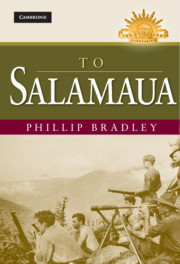Book contents
- Frontmatter
- Contents
- Foreword
- List of illustrations
- Acknowledgements
- Abbreviations
- Introduction
- 1 Death in the Bismarck Sea
- 2 Opposing forces
- 3 Warfe's tigers
- 4 Supply lines
- 5 Mubo stalemate
- 6 On Lababia Ridge
- 7 On Bobdubi Ridge
- 8 Yanks
- 9 Mubo falls
- 10 ‘A bit of a stoush’
- 11 The forbidden mountain
- 12 Roosevelt Ridge
- 13 Old Vickers
- 14 Komiatum Ridge
- 15 Across the Frisco
- 16 Salamaua falls
- Appendix: Place names
- Notes
- Bibliography
- Index
- Frontmatter
- Contents
- Foreword
- List of illustrations
- Acknowledgements
- Abbreviations
- Introduction
- 1 Death in the Bismarck Sea
- 2 Opposing forces
- 3 Warfe's tigers
- 4 Supply lines
- 5 Mubo stalemate
- 6 On Lababia Ridge
- 7 On Bobdubi Ridge
- 8 Yanks
- 9 Mubo falls
- 10 ‘A bit of a stoush’
- 11 The forbidden mountain
- 12 Roosevelt Ridge
- 13 Old Vickers
- 14 Komiatum Ridge
- 15 Across the Frisco
- 16 Salamaua falls
- Appendix: Place names
- Notes
- Bibliography
- Index
Summary
Although no large-scale offensive was called for in front of Mubo, Moten was encouraged to occupy any vacated enemy positions should the Japanese pull back. At this stage the Japanese had a protective screen at Guadagasal to enable the remnants of the Okabe Detachment to return from Wau. From these positions they controlled the Mubo end of both the Buisaval and Black Cat tracks and prevented any Australian move on to Lababia Ridge. On 7 March another hundred enemy soldiers dug in around Guadagasal, indicating an intention to hold the area, a prerequisite for any renewed move on Wau from Mubo. Despite the loss of the Bismarck Sea convoy, the Japanese command still had designs on Wau, or at least wanted the Australian command to continue to believe so.
Moten's orders to Lieutenant-Colonel Danny Starr, commander of the 2/5th Battalion, were to ‘gain contact with enemy and not lose it’. As the month of March began, Starr had two platoons forward, manning observation posts to check on any enemy move up the Black Cat Track. The rest of Starr's men were spread out all the way back to Crystal Creek outside Wau, protecting Buisaval Track. The majority of these men were involved in road construction, the building of accommodation at Skindiwai and the carrying of supplies forward. Due to the limited number of troops in the forward area, Starr considered operations impracticable without sacrificing control of the Buisaval and Black Cat Tracks.
- Type
- Chapter
- Information
- To Salamaua , pp. 106 - 119Publisher: Cambridge University PressPrint publication year: 2010



